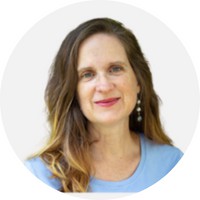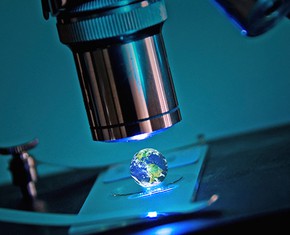The views expressed in our content reflect individual perspectives and do not represent the authoritative views of the Baha'i Faith.
On Friday, October 20, the U.S. observes National Mammography Day. Ah, mammograms! The funny, one-size-fits-someone gowns. The weird poses. The squashing! Who enjoys getting their mammogram?
Nobody, that’s who.
But who is grateful that they exist – and are available to more and more women?
I am, for one. I was diagnosed on June 1, 2020, with stage one breast cancer. The 0.6cm lump was found through a routine annual mammogram. I had no family history of breast cancer, could not detect this small lump through self-exam, and felt perfectly well. The diagnosis was shocking and scary, and medical procedures are daunting and stressful. But my excellent treatment was minimally invasive because of my early detection through the mammogram. The cancer is gone now, and my prognosis is excellent.
As I look back at my diagnosis and treatment, I see it as an example of the miracle of the age we live in, a miracle I believe was brought about by the power released by the coming of Baha’u’llah, the prophet and founder of the Baha’i Faith. The Baha’i writings proclaim that we are in a special moment in human history, saying that the forces of Baha’u’llah’s revelation “have instilled into humanity the capacity to attain … [the] final stage in its organic growth and collective evolution.”
“We have … breathed a new life into every human frame and instilled into every word a fresh potency. All created things proclaim the evidences of this world-wide regeneration,” wrote Baha’u’llah.
The release of this power has real effects. Abdu’l-Baha, Baha’u’llah’s son and successor, explained:
See how, in this day, the scope of sciences and arts have widened out, and what wondrous technical advances have been made, and to what a high degree the mind’s powers have increased, and what stupendous inventions have appeared. This age is indeed as a hundred other ages: should ye gather the yield of a hundred ages, and set that against the accumulated product of our times, the yield of this one era will prove greater than that of a hundred gone before.
My enthusiasm is not a common reaction to this age, perhaps. We can easily be dismayed by the world’s dysfunctions when we tune in to the media on every side, and its relentless focus on what is clearly broken and outmoded. As a result of what we see and hear, we may feel that humans are at cross-purposes, that we are awful to each other, selfish by nature, and interested most in our own advantage.
And yet look what we manage to do! We make scientific discoveries for the good of all. We develop tools and protocols based on shared information, and improve both testing and outcomes.
“All men have been created to carry forward an ever-advancing civilization,” wrote Baha’u’llah. Here’s one definition of civilization: “the stage of human social and cultural development and organization that is considered most advanced.” Another definition mentions “a relatively high level of cultural and technological development.” We are, at this stage of human development, more advanced than ever, but our work is not done. The very purpose of our creation, Baha’u’llah taught, is to do our part to carry all of us into a better world:
The Almighty beareth Me witness: To act like the beasts of the field is unworthy of man. Those virtues that befit his dignity are forbearance, mercy, compassion and loving-kindness towards all the peoples and kindreds of the earth.
Clearly we human beings can and do act no better than animals – or even worse. But an ethic of working for the common good is a value that comes from the heart of who we are as spiritual beings, our true reality. As a Baha’i of more than 30 years, I try to look at all aspects of my life through the lens of the Baha’i Faith and its teachings, which center around our human unity and our role as individuals to serve the common good.
So I see the world’s rapid medical and scientific advancements as examples of the altruistic spirit of the age, and as evidence of the potent energies released by the revelation of Baha’u’llah. A look at the American Cancer Society’s timeline of cancer discoveries has its first entry in the 1770s, then nothing until the mid-1800s, at the beginning of the revelation of Baha’u’llah. From that point on, there are incredible discoveries in quick succession until the present.
Abdu’l-Baha advised us all to: “Rejoice and be glad that this day has dawned, try to realize its power, for it is indeed wonderful!” The power and speed of our advancements is astounding. My grandmother-in-law had breast cancer in the 1950s. Mammograms were not routine, so she didn’t get a diagnosis until she was quite ill. Her treatment was nitrogen mustard, which prolonged her life for a couple of years, perhaps. She died at age 51. By 1976 mammograms were recommended by the American Cancer Society. Now they are a major tool in our kit. Treatments continue to be revolutionized as we learn more.
Does our medical system work perfectly? Clearly not. I’m frustrated and dismayed by the lack of access to good treatment many of us face, and by the way our system often puts profit before people. I also know that we still have so much to learn about health and healing. We will no doubt look back at our current cancer treatments in a decade or two and be amazed at how little we knew! Hopefully we will also make great strides in cancer prevention, and address the environmental factors that are leading to its proliferation. There is a lot of work to do.
We can be grateful, though, for continual advances in our collective understanding. I have been heartened by my collaboration with my current oncologist, and the spirit of service exhibited by the surgeon who performed my lumpectomy. She looked me in the eye and told me she would care for me as if I were her own sister. These experiences bolster my faith in humanity’s inherent goodness, our desire to see each other thrive, and our ability to work together for the betterment of humanity and the world.
So on this National Mammography Day, I encourage you, if you are a woman for whom a mammogram is indicated, to take advantage of your option for a routine screening. The CDC recommends women at average risk get a mammogram every two years from age 50 to age 75. Women with a family history of breast cancer or women who carry certain genes associated with breast cancer can discuss a testing strategy with their doctors, perhaps starting to test earlier or testing more often.
And afterwards? Take yourself for an ice cream or a walk in the park. You did it! Say a prayer of thanks that we live in this marvelous age, an age when the secrets of the universe are being uncovered, an age when we can see our collective progress.
You May Also Like
Comments

















The Tablet of the Holy Physician comes to mind.